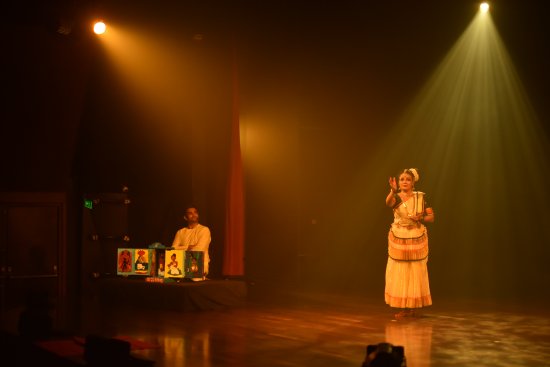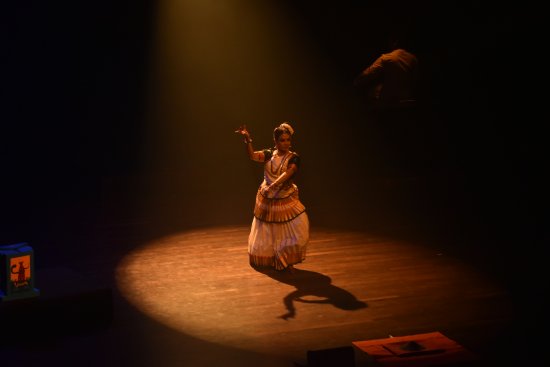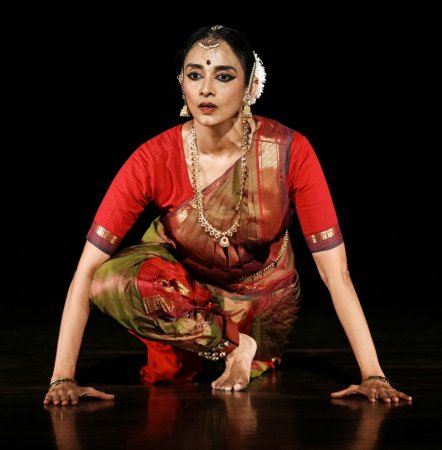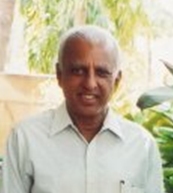
|   |

|   |
Manthan and Prabodhan impress - Satish Suri e-mail: satishism@yahoo.co.in June 9, 2025 MANTHAN Photos: Prof.K.S.Krishnamurthy When the churn of myth meets the flow of classical tradition, the result is a shimmering amalgam of time, truth, and transformation. Manthan, presented on May 7th at the Bangalore International Centre by Divya Warier and Akshay Gandhi, was precisely that - a layered, multidisciplinary retelling of the Samudra Manthan, the cosmic churning of the ocean, expressed through Indian classical dance, Kaavad storytelling, and philosophical inquiry. The performance reimagined the myth through seven pivotal moments - from Durvasa's curse to Mohini's deception - blending the lyrical grace of Mohiniyattam with the vivid oral tradition of Rajasthan's Kaavad.  The evening opened with a traditional Sollukattu, its percussive syllables setting a primordial rhythm. Divya entered with crisp adavus, her outstretched mudras evoking the fragile alliance of Devas and Asuras. Her portrayal was rooted in command and clarity, each gesture and glance precise, her dance a kinetic invocation of cosmic forces. Parallelly, Akshay Gandhi, wielding the 400-year-old Kaavad shrine, unfolded its first panel - Durvasa cursing Indra - his narration in Hindi flowing with poetic cadence. As the story unfolded, Divya's abhinaya mirrored Indra's shame with furrowed brows and clenched mushti mudras, while her sidelong glances suggested the inevitability of divine intervention. At the heart of Manthan lay a bespoke Varnam, composed in Shankarabharanam raga by Shyam Kalyan. It served as the narrative and choreographic spine of the evening. Divya's movements alternated between vigorous stamping and sweeping arms that echoed the churning ocean, and Mohiniyattam's inherent fluidity as she portrayed the spreading of Halahala, the deadly poison. Her torso undulated like waves of venom, her breath-controlled phrasing conveying the weight of cosmic imbalance. When Shiva emerged to consume the poison, the lighting turned a sombre blue. Divya's gestures softened into flickering wrists and lifted glances, embodying surrender and compassion, while Akshay's narration imbued the moment with reverent stillness as Mount Mandara trembled and treasures emerged. The dramatic arc culminated in the arrival of Mohini. As Akshay unveiled the Kaavad panel showing her bearing the Amrita, his voice lowered into a whisper, rich with irony and seduction. Divya's performance here was a study in nuance - sly smiles for the Asuras, sharp pralokita drishti toward the Devas, an elegant negotiation between enchantment and divine strategy. The illusion shattered as she beheaded Rahu, her Tripataka mudra slicing the air with a ferocity reminiscent of the Sudarshana Chakra. The inclusion of Ravana's defeat - an unconventional but potent addition - layered the myth further, reframing Mohini's triumph as not merely victory over deception, but as a metaphorical dissolution of ego. In a stunning pivot, the performance shifted into a melancholic interlude set to a Mohiniyattam padam in Bhairavi raga. Here, the narrative paused to reflect. Divya returned, her movements slowed, her Mukula mudras trembling like a flower wilting in grief. The edakka's gentle pulse and a plaintive flute line deepened the sorrow. Her eyes shimmered with alokita drishti, suggesting mourning - whether for the Asuras, for cosmic imbalance, or for the cycle of suffering itself, remained deliberately unresolved. Akshay's voice, now hushed, seemed to echo the silence of the Kaavad's mourners, grounding the myth in emotional realism.  As if in rebirth, the Thillana erupted in joyous release, its composition in Kalyani raga interwoven with verses by Kabir. Divya's choreography here radiated exuberance - intricate footwork paired with lyrical sway, her mudras translating Kabir's metaphors into movement. The illusion of duality gave way to spiritual transcendence, her smile luminous, the dance becoming an offering of insight. Akshay's final panel - perhaps a symbolic cosmos - closed the performance with quiet gravitas, his recitation merging seamlessly with the crescendo of music. It was a convergence of the visual, the verbal, and the visceral. Divya's artistry was marked by emotional depth and technical finesse - her portrayal of Mohini's seductive playfulness was as assured as her descent into grief. Each adavu, each mudra, each glance was imbued with narrative clarity. Akshay's role was equally central - his narration did not simply accompany the dance; it conversed with it, giving it historical and philosophical contour. His stewardship of the Kaavad, both as a physical object and as a symbolic portal, grounded the performance in a rich performative lineage. Manthan became a contemporary churning of artistic disciplines, yielding not just amrita, but insight. The performance's echoes lingered long after the final note faded, leaving the audience not only moved but meaningfully stirred. PRABODHAN - AN AWAKENING Photo: Prof.K.S.Krishnamurthy Lakshmi Parthasarathy Athreya's Bharatanatyam recital, titled 'Prabodhan' (An Awakening), held at the Bangalore International Centre on June 4, 2025 unfolded as a vibrant tapestry woven with devotion, cosmic revelation, and environmental consciousness. A senior disciple of Chitra Visweswaran, Lakshmi brought to the stage her hallmark blend of grace and dynamism, presenting five distinct pieces. Each composition explored a unique dimension of awakening - spiritual, metaphysical, or ecological - with striking technical finesse and emotive depth. In "Madurapuri Chokkar Kauthuvam" she evoked the arresting beauty of Lord Siva through his iconic adornments - matted locks, tiger skin, elephant hide, the crescent moon, and the cascading Ganga. With equal fervour, she portrayed his fierce prowess through the dramatic episodes of Tripura Dahanam and the incineration of Manmatha, weaving together awe and aesthetics in her interpretation. The choreography of her Guru Chitra Visweswaram, was a dynamic interplay of rhythmic precision and narrative grace. Crisp adavus and soaring utplavanas vividly captured Shiva's vigour, while her use of diagonal stage lines and deep araimandi stances amplified the deity's divine energy. Her abhinaya, marked by radiant eyes and supple wrist movements, brought out Shiva's benevolence with quiet eloquence. Subtle glances and spirited gestures conveyed the devotee's journey of inner awakening, setting a reverent tone for Prabodhan, further enriched by Murali Parthasarathy's resonant vocals.  Lakshmi Parthasarathy Athreya The centrepiece of the recital, 'The Dot That Moved', was a bold and evocative interpretation of the Shiva Tandava Stotram, centred on Ravana's encounter with the divine. Here, Lakshmi ventured into more experimental terrain, merging traditional Bharatanatyam vocabulary with theatrical innovation. Her portrayal of Ravana's arrogance was forceful and expansive, with dynamic footwork and sculptural mudras. The representation of Shiva's celestial grandeur, especially through swirling depictions of his matted tresses, was executed with finesse and imagination. In a particularly audacious moment, Lakshmi employed her recitation of verses and a sudden, visceral scream to convey Ravana's agony as Mount Kailasa crushed his hands. The moment was arresting, even briefly jarring, but it encapsulated the dramatic intensity of the episode and underscored her willingness to take creative risks. Regaining momentum with her commanding stage presence, she continued with vigorous adavus and spatial choreography that captured the cosmic energy of tandava. The evocative music composition by Dr Rajkumar Bharathi added sonic depth and dramatic texture, underscoring the intensity of the performance. The next piece, "Eppadi Manam Thunindado", drawn from the Ayodhya Kanda of the Ramayana, offered an emotionally charged portrayal of Sita's confrontation with Rama as he prepares to enter exile. It was a study of dignified anguish and relational rupture. Lakshmi's choreography skillfully blended measured adavus with sweeping torso movements, and her angular stage patterns mirrored Sita's inner turbulence - structured yet restless, contained yet volatile. Her abhinaya was profoundly affecting. In Sita's voice, she asked, "How can you even bear the thought of leaving me?" - a plea that rang with both vulnerability and quiet resistance. Her eyes brimmed with defiance, hurt, and enduring love, while her delicate hand gestures traced memories of Rama's promise of eternal unity across lifetimes. The emotional crescendo came as she conveyed the searing line: "By distressing me again and again, you kill me without killing me with your words." Lakshmi's trembling frame, quivering lips, and hesitant movements captured the raw fragility of heartbreak - an emotional awakening rendered in flesh and feeling. The poignancy of the piece was further deepened by the vocal rendering of Ila Sangeeta Dilip, whose soulful interpretation conveyed the emotional weight embedded in Arunachala Kavi's timeless composition. While the intensity of the portrayal occasionally risked tipping into theatrical excess, Lakshmi's nuanced restraint ensured the pathos never overshadowed the poetics. The piece that followed, 'Ode to Ganga', marked a shift from mythic grandeur to a poignant contemporary reflection. It served as a lament on humanity's insensitivity toward sacred water bodies and environmental degradation. Set to the raga Amrithavarshini - aptly translating to "rain of nectar" - with music composed by Dr Rajkumar Bharathi, and vocalised by G.Srikanth, the piece harnessed both lyrical beauty and thematic urgency. Through the metaphor of the Ganga, revered and yet defiled, the choreography invited an ecological awakening rooted in cultural memory. Lakshmi's abhinaya shone with quiet intensity. Her expressive eyes mirrored sorrow and supplication, while subtle gestures - cupped hands, downward glances, and supplicating movements - embodied the river's plea and the collective guilt of human neglect. The choreography was minimal yet deeply evocative, allowing the music's emotional charge and the dancer's interpretive strength to converge. Her portrayal moved beyond lamentation, becoming a call to conscience, gently urging the audience to reflect on their role in sustaining or destroying the natural world. This piece stood out for its ability to translate a socio-environmental concern into a deeply personal and artistic experience, resonating with the overarching theme of Prabodhan. The concluding piece of Prabodhan was 'Chakra Alarippu'. Lakshmi Parthasarathy Athreya's reimagining of the traditional alarippu, elevated the pure nritta format into a powerful exploration of inner awakening. Traditionally performed as a rhythmic invocation that primes the dancer's body and mind, the alarippu is known for its structured geometry and crisp teermanams. Lakshmi's version expanded its philosophical canvas, aligning the dance with the concept of the body as a sacred vessel by mapping the journey through the seven chakras - from muladhara to sahasrara. Her choreography was a tour de force. Spiralling adavus, shifting levels, and ascending footwork became markers of energy rising through the subtle body. Each rhythmic pattern corresponded to a vibrational centre: grounded, forceful stomps for the Muladhara, fluid torso undulations for the Anahata, and airy, soaring movements for the Sahasrara. Executed with unwavering clarity and precision, every movement mirrored the resonance of a particular chakra, evoking a visceral sense of ascent and release. Her use of diagonal stage lines, concentric pathways, and deeply held araimandi stances formed a living mandala, lending the piece a meditative visual symmetry. Dr Murali Parthasarathy's resonant vocals and rhythmic articulation wove a rich sonic tapestry that complemented the rising intensity of the piece, while the subtle lighting design by Surya Rao added a luminous dimension. As the performance reached its zenith, each energy centre seemed to illuminate in harmony with the dancer's ascending form, culminating in a final freeze that was at once still and transcendent, a moment of embodied Prabodhan - An Awakening.  Bangalore based Satish Suri is an avid dance rasika besides being a life member of the Music and Arts Society. |